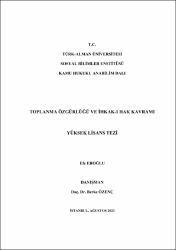| dc.contributor.author | Eroğlu, Efe | |
| dc.date.accessioned | 2024-03-13T18:54:32Z | |
| dc.date.available | 2024-03-13T18:54:32Z | |
| dc.date.issued | 2023 | en_US |
| dc.date.submitted | 2023-09-05 | |
| dc.identifier.citation | Eroğlu, Efe (2023). Toplanma özgürlüğü ve ihkak-ı hak kavramı. Türk-Alman Üniversitesi, Sosyal Bilimler Enstitüsü, İstanbul. | en_US |
| dc.identifier.uri | https://hdl.handle.net/20.500.12846/780 | |
| dc.description.abstract | Çalışma kapsamında Antik Yunan Demokrasisi ile modern temsili demokrasilerin
tarihsel süreç içerisindeki dönüşümü incelenerek, demokrasinin zaman içerisindeki
değişimi ele alındı. Bu bağlamda demokrasilerde yurttaşların yönetime katılma hakkını
kazanması incelendi. Modern demokrasilerde yurttaşların yönetime katılımın seçimle
sınırlandığı tespit edilerek, ifade ve toplanma özgürlüğünün yurttaşların siyasal iradesinin
oluşumuna katkıları ortaya kondu. Bunun ardından ihkak-ı hak kavramı tanımlanarak,
sivil itaatsizlik ile arasındaki farklar açıklandı. İhkak-ı hak eylemlerinin toplanma
özgürlüğü ile örtüşen unsurları tespit edildikten sonra, ihkak-ı hak eylemlerini toplanma
özgürlüğünün koruması dışına çıkaran unsurlar ortaya kondu. Farklı İhkak-ı hak
eylemleri tanımlanarak, oturma eylemi şeklinde gerçekleşen ihkak-ı hak eylemlerinin
hukuk düzeni tarafından korunup korunmadığı değerlendirildi. Ardından yaratıcı ihkak-ı
hak metotları aktarılarak toplanma özgürlüğü kapsamında korunmaları tartışıldı. | en_US |
| dc.description.abstract | Within the scope of the study, the transformation of Ancient Greek Democracy and
modern representative democracies in the historical process was examined and the change
of democracy over time was discussed. In this context, citizens' gaining the right to
participate in governance in democracies was analysed. In modern democracies, it was
determined that citizens' participation in government is limited to elections, and the
contribution of freedom of expression and assembly to the formation of the political will
of citizens was revealed. Afterwards, the concept of direct action was defined and the
differences between it and civil disobedience were explained. After identifying the
overlapping elements of direct action with the freedom of assembly, the elements that
exclude direct action from the protection of the freedom of assembly were revealed. By
defining the different types of direct action, it was evaluated whether direct action in the
form of sit-in protests are protected by the legal order. Subsequently, creative methods of
direct action were analysed and their protection within the scope of freedom of assembly
was discussed | en_US |
| dc.language.iso | tur | en_US |
| dc.publisher | Türk-Alman Üniversitesi Sosyal Bilimler Enstitüsü | en_US |
| dc.rights | info:eu-repo/semantics/openAccess | en_US |
| dc.subject | Democracy | en_US |
| dc.subject | Freedom of assembly | en_US |
| dc.subject | Sit-in protests | en_US |
| dc.subject | Direct action | en_US |
| dc.subject | Demokrasi | en_US |
| dc.subject | Toplanma özgürlüğü | en_US |
| dc.subject | Oturma eylemi | en_US |
| dc.subject | İhkak-ı hak | en_US |
| dc.title | Toplanma özgürlüğü ve ihkak-ı hak kavramı | en_US |
| dc.title.alternative | Direct action in the context of freedom of assembly | en_US |
| dc.type | masterThesis | en_US |
| dc.contributor.authorID | 0000-0002-5577-4420 | en_US |
| dc.relation.publicationcategory | Tez | en_US |
| dc.contributor.department | TAÜ, Sosyal Bilimler Enstitüsü, Kamu Hukuku Ana Bilim Dalı Koleksiyonu | en_US |

















